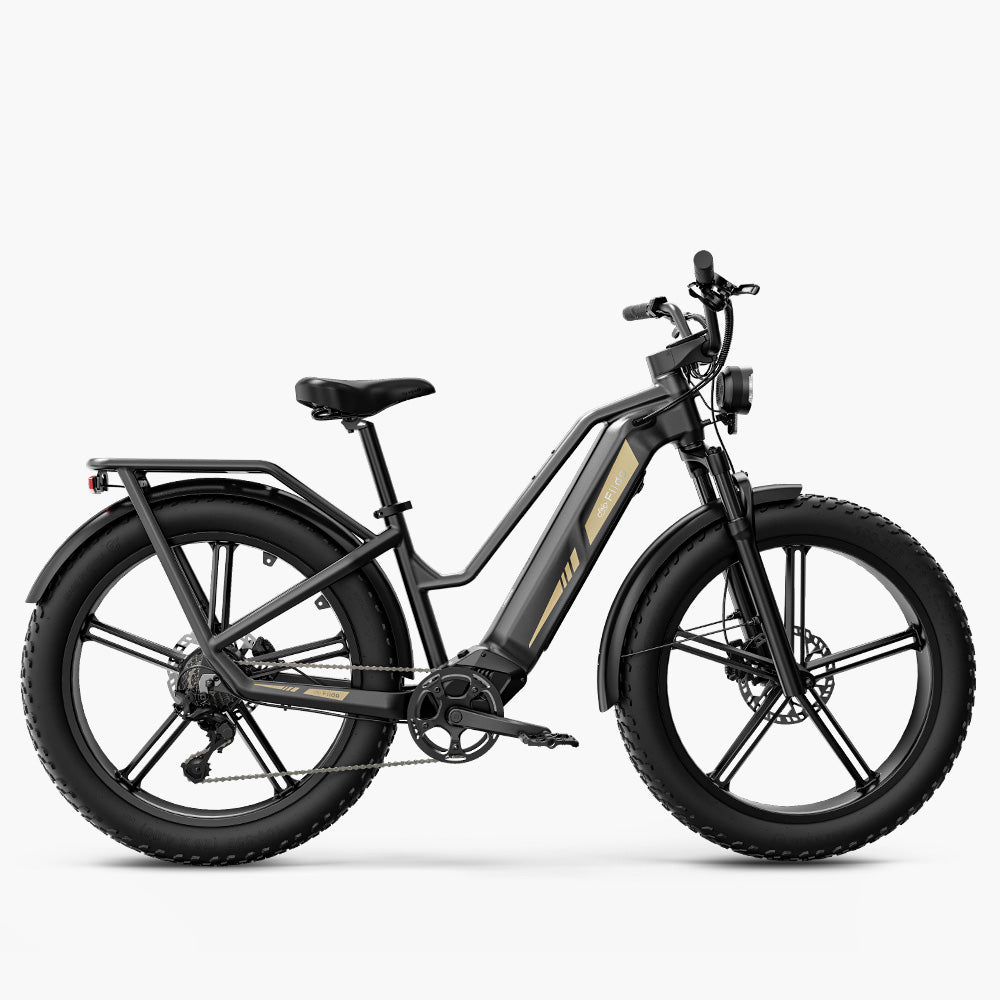Winter doesn't have to be an obstacle for daily commuting on an e-bike – quite the opposite! Many commuters swear by switching to an e-bike during the colder months to avoid traffic jams and enjoy the fresh air. But how can you ensure that your e-bike continues to work reliably in freezing temperatures? In this article, we will reveal the necessary adjustments and preparations to make your e-bike winter-ready and ensure a safe commute to work.

Winter-Ready E-Bike Equipment
The winter months present special challenges for e-bikers. To commute to work safely and comfortably, the right equipment is essential. The following accessories should be considered:
Winter Tires or Studded Tires: The right tires are crucial for safe riding on snow and ice. Winter tires offer better grip on slippery roads, while studded tires are especially suitable for unpaved or icy paths. Be sure to regularly check the tire pressure, as cold temperatures can affect it. Fat tire electric bikes are particularly advantageous on rainy winter days, especially in terms of traction, stability, and comfort. These characteristics ensure that they perform exceptionally well on slippery, muddy, or water-covered roads.
Bicycle Lighting: In winter, it often gets dark early, and visibility is critical. Ensure that your e-bike is equipped with sufficiently strong headlights and taillights so that you can be seen clearly by other road users.
Mudguards and Splash Protection: Roads are often wet and dirty in winter. Mudguards prevent dirt and water from splashing onto your clothes, which is particularly appreciated during longer rides.
Gloves, Waterproof Clothing, and Winter Jackets: Protect yourself from the cold by investing in insulated, waterproof clothing. Gloves, in particular, that allow for a good grip even in low temperatures, are essential.
Can I ride an electric bike in sub-zero temperatures
Winter can pose some challenges for e-bikes and their riders, especially extreme cold temperatures, which affect the bike's technology and handling. Below, we describe the most common problems and offer practical solutions.
-
Battery Performance: Cold is one of the biggest enemies of the e-bike battery. At temperatures below 0°C (32°F), the battery’s performance drops drastically. The chemical reactions responsible for energy production slow down, leading to reduced range. In very low temperatures, the battery may even discharge faster or fail to charge fully.
Solutions:
-
Proper Battery Storage: Always store the battery at room temperature if possible, as this optimizes its lifespan and performance in cold weather.
-
Prepare the Battery Before Riding: In cold weather, always take the battery inside to a warm room before installing it on the bike just before your ride. This keeps the battery effective for the ride.
-
Regular Charging: Charge the battery in a warm room before using it to ensure it has enough power for the ride.
-
Frozen Brakes: In extremely cold temperatures, water present in the brakes or brake pads can freeze. Frozen brakes significantly impair braking performance and can compromise safety during the ride. This is particularly problematic in wet and frosty conditions, where moisture accumulates in the brake mechanisms.
Solutions:
-
Regular Brake Checks: Before riding, make sure the brakes are thoroughly maintained and cleaned. Ensure they are free from water, ice, and dirt.
-
Brake Pad Maintenance: Regularly check the condition of the brake pads and replace them if necessary. In extreme winter conditions, specially treated brake pads can be used that are less prone to freezing.
-
Dry the Brakes: When you need to park the bike, place it in a location where the brakes are protected from moisture and ice.
-
Lubrication and Chain Care: Cold and wet weather can also affect the chain’s lubrication. Water and dirt freezing in the chain can cause the drivetrain to block or run unevenly. The chain can wear out faster in very low temperatures, and the gears may shift erratically.
Solutions:
-
Use Winter-Specific Lubricants: Use special winter lubricants that perform well in low temperatures. These lubricants are more resistant to water and cold and prevent the chain from freezing.
-
Clean the Chain Regularly: Thoroughly clean the chain before and after each ride to remove dirt and moisture. This prevents water and salt from settling in the chain and causing faster wear.
-
Chain Maintenance: Be sure to lubricate the chain regularly, especially if you're riding in wet or salty conditions. A well-maintained chain ensures smooth and efficient riding.
Many people wonder if it’s possible to ride an electric bike in temperatures below freezing. Generally, it is possible to ride in cold weather as long as the e-bike is well-maintained and you have the right equipment. However, you should be cautious about extreme weather conditions such as heavy snowfall, icy roads, or fog, which can make riding dangerous.
To increase safety, it's recommended to ride cautiously when temperatures are below 0°C (32°F) and to pay special attention to slipperiness and other unpredictable road conditions. In extreme cold conditions, such as those found in northern Germany or the Alpine regions, you might consider switching to the car or public transport on particularly cold days.

Winter E-Bike Storage
After you’ve completed your commute to work, the next question is how to store your e-bike properly during the winter months. To protect the bike from cold temperatures and moisture, it’s best to store the e-bike in a dry, warm place. If you have to park your bike outside, use a cover or waterproof bike shelter to protect it from snow and rain.
It’s especially important not to leave the battery in the e-bike during winter. Store the battery at room temperature to ensure optimal lifespan and performance. Additionally, regularly check the condition of the brakes and tires, as they are more susceptible to wear in cold weather.
Recommended E-Bikes for Winter Commuting
Not all e-bikes are suitable for winter use. For commuting in cold temperatures, models with a robust build and good winter suitability are recommended. Two models from Fiido are particularly well-suited for winter commuting:
Fiido M1 Pro: The Fiido M1 Pro Fat-Tire E-Bike is ideal for winter road conditions. Its wide, stable tires offer good grip on snow and ice, ensuring a secure ride on slippery surfaces. It is especially robust and well-suited for off-road adventures as well as winter commuting.
Fiido M1 Pro Fat Tire Electric Bike
The most cost-effective fat tire ebike for off-road adventures.
Reminder: Prices are subject to the product detail page ,some earlier card details may have been updated.
Fiido Titan: The Fiido Titan Off-Road Electric Bike is another versatile model that is suitable for all seasons. With a high range and strong tires, it’s especially suited for longer winter rides. The sturdy construction and comfortable riding style make it an excellent choice for commuters who want to reliably ride in snow and cold.
Fiido Titan Robust Cargo Electric Bike
A powerhouse with a 347 km range and 4-piston brakes, ideal for hunting and fishing trips.
Reminder: Prices are subject to the product detail page ,some earlier card details may have been updated.
Conclusion
Commuting to work on an e-bike in winter is a healthy, cost-effective, and environmentally friendly alternative to driving. However, it requires some preparation and the right equipment to stay safe and comfortable during the cold season. With the right winter tires, weatherproof clothing, and a well-maintained e-bike, you can easily commute to work in winter and enjoy all the benefits of e-bike riding.

















